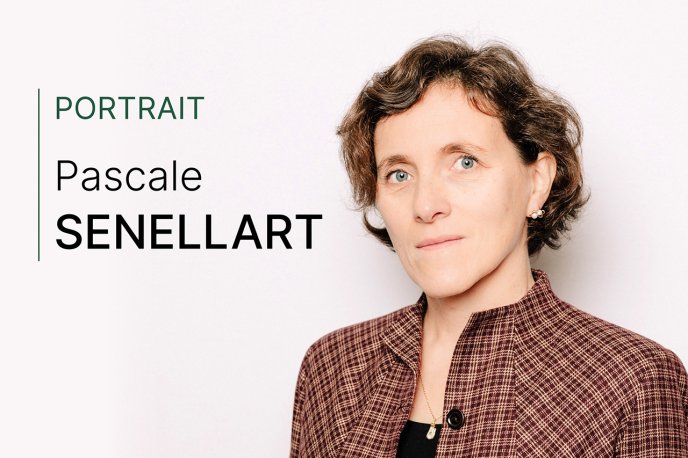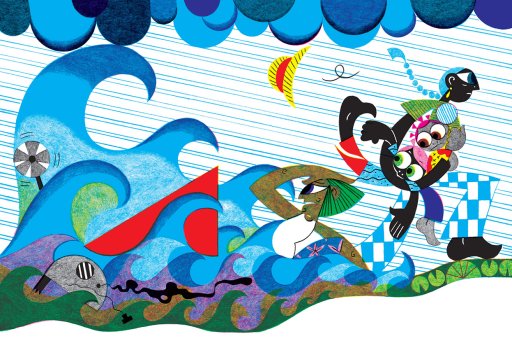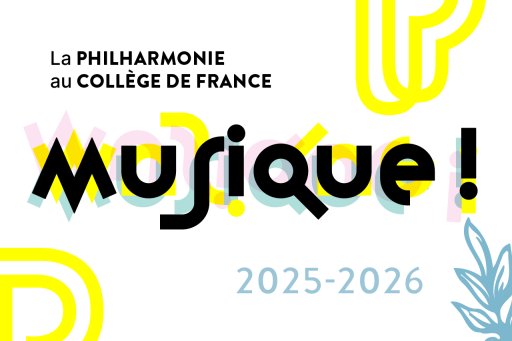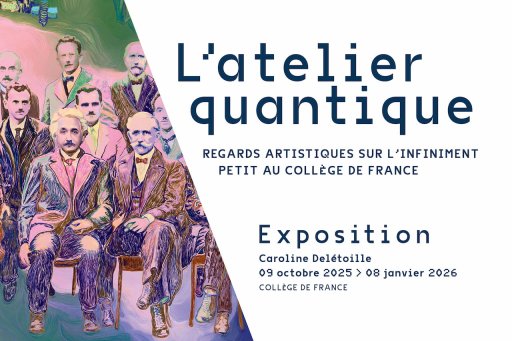Passionate about quantum physics, Pascale Senellart wants to put light at the service of tomorrow's technologies. Her research into semiconductor quantum dots is enabling the development of quantum computing and communication tools using the photons they generate.
In 2025-2026, she has been invited to occupy the Technological Innovation Liliane Bettencourt Annual Chair at the Collège de France.
How did you become interested in science, and then physics ?
Pascale Senellart: When I was a child visiting my grandparents, we always passed the Nançay Radio Observatory. It's an immense and impressive structure, lost in the middle of nature, which fascinated me greatly. So I asked them to take me on as an intern in my ninth year, and I was wonderfully welcomed by the technicians, engineers and researchers, who gave me tasks that matched my abilities at the time. For several years, I returned several times : first to do welding, then programming. The last year, when I was 18 years old, they called me because one of the observers needed to be replaced at short notice for a while. I'm still fascinated by the large instruments that illustrate how high-flying engineering enables scientific exploration. But I soon realized that astronomy was of less interest to me, because the objects it observes are far away, and the experimenter is not in a position to quickly change the way he interrogates the system to answer the questions he has. Then I discovered quantum mechanics during an oral exam to enter the École normale supérieure in Lyon. By making me think about what happens if a photon passes through two slits at once, the examiners awakened me to some absolutely fascinating notions. It was a wake-up call. I knew from then on that I wanted to go into this field of research.
Since 2002, your work has taken you to the intersection of quantum optics and semiconductor materials. What were the challenges of this interface at the time you began working on it ?
Since the 1980s, it had been imagined that certain semiconductor nanostructures - known as quantum boxes - could behave like a single atom. Experimental confirmation came in the early 2000s with the demonstration that these quantum dots could emit photons one by one, but this was still in its infancy, and very inefficient. The photons were emitted in all directions in space, and did not have the quantum properties we were looking for. An idea then emerged : to collect these photons, the quantum box had to be placed in an optical cavity - a resonance chamber that made the way atoms emit light much more directive. The proofs of concept that exist at this time, however, involve sets of emitters. So, to arrive at a single emitter, I drew up a rather ambitious CNRS project - which I didn't know at the time, because when you're starting out in this business, you're always a bit naive. To begin with, I wanted to reproduce in semiconductor materials very pure quantum mechanical experiments, such as those carried out by Serge Haroche at the Collège de France. In these, he sent atoms one by one into microwave cavities, demonstrating a very strong coupling between an atom and a photon. My first objective was to reproduce this in semiconductor materials, where the physics is more " dirty ", notably because many atoms vibrate. Then, I wanted to see how far I could " clean " this system to get closer to a very pure quantum model system. In 2005, we succeeded in demonstrating this strong coupling between an atom and an optical cavity. Shortly afterwards, in 2007, I invented a technology for coupling a quantum box and an optical cavity in a controlled manner - it was a technology development that profoundly changed the way we conducted our subsequent research.
What prospects has the demonstration of this coupling opened up?
Once we had this tool - and we were among the first in the world - we could generate entangled photons efficiently and reproducibly. Thanks to this, by 2010 we had built one of the world's brightest sources of entangled photons. I then started to be contacted by people who were trying to develop a quantum computer or quantum communication by exploiting single photons or entangled photons. In particular, Prof. Andrew White of the University of Queensland, Brisbane, Australia, a leader in the field, thought our work was great, and encouraged us to go even further. He suggested that we produce indistinguishable photons, i.e. photons that possess high quantum coherence, enabling what is known as quantum interference. This property lies at the heart of all light-based quantum technologies. Think of it as a building block that must be mastered in order to use photon systems. This represented an additional challenge : we had to find a way to isolate our little transmitter from the mechanical, magnetic and electrical vibrations that are naturally present in its environment, and succeed in producing these very identical photons. By 2015, we had done just that ! We had highly indistinguishable photons, with components manufactured in a systematic, reproducible way, and endowed with record efficiency. We had one foot in the world of quantum technologies.
How did you make the transition from your research work to a world of technological applications ?
We could already see the potential applications for our components in quantum computing, quantum communication networks, and maybe even quantum sensors one day, because light is a truly versatile tool. In 2015, we came up with the idea of creating a start-up, as many people wanted to collaborate with us and gain access to our components. But these were still only laboratory prototypes, and quite difficult to use. So we wanted to work on making them easier to use, and so founded Quandela in 2017. A colleague and friend, Prof. Khaled Karrai, who set up the Attocube company in Germany, guided us on the commercial side of this project, which I had not mastered at all. Together, we also discussed the strengths and weaknesses of the technology and identified the developments that needed to be stabilized. This was a long-term job, as we had to test the reproducibility of our technique and integrate sources into complete systems to emit photons one by one. The first components supplied by Quandela were still laboratory items, but the first customers were keen to learn how to use them. Then, more recently, we released very easy-to-use single-photon sources, for which the user needs no prior technical knowledge : everything is automated.
How has the landscape of technological applications changed since the launch of your start-up ?
Quandela is one of France's first quantum technology start-ups. When we launched, the ecosystem was very different from what it is today. We had to explain quantum technologies to a number of French research institutions. At the time, there wasn't much enthusiasm for this kind of exercise, but I'm amazed at how quickly things have evolved. I was an extraterrestrial when we were trying to create a start-up in 2015, and since then, many quantum researchers have taken the plunge. This is important, because we're in the middle of a pretty scary international technology race, the stakes of which are identified as absolutely sovereign. Indeed, a state or a company that has a quantum computing processor at its disposal, known as " universal ", before the others, could upset the international balance of power, having at its disposal computing resources inaccessible to today's best supercomputers.
What do you make of this sudden acceleration in the world of computing, this emergence of a certain form of international competition and the stakes involved ?
Our world has really changed in recent years. For example, we can no longer collaborate with certain countries on these technologies, which is a great pity and complicated in the scientific world. There's also strong emulation linked to the fact that there are several platforms : you can make a quantum computer with superconducting qbits, atoms, silicon components... So there's a lot of scientific competition, but also a lot of cross-fertilization, i.e. positive effects from one community on the other. A scientific success in one physical system will influence others, and sometimes unlock a technological lock in another approach. All in all, it's great to see this large community emerging from smaller communities that didn't communicate with each other before. As recently as fifteen years ago, we weren't talking much with researchers handling atoms or superconducting qbits, and now we're all in the same community. We've seen a real decompartmentalization of the optics, cold atoms, superconductors and semiconductors communities - so many technical sectors, where we used to manipulate the same concepts without really talking to each other about them. This multi-disciplinary approach is very fruitful and absolutely fascinating. We are also working with specialists in quantum algorithms to adapt them to our hardware, and with artificial intelligence specialists to optimize our processors.
In 2025, you will be awarded the Technological Innovation Liliane Bettencourt Annual Chair at the Collège de France. What does it mean to you and what do you expect from it ?
I'm delighted to have been asked to teach at the Collège de France. I started out as a research director at the CNRS, an experimentalist, and my husband and I had three children quite early on in my career. So I got into teaching rather late when I felt I could manage everything in parallel - a dozen years ago. But I discovered that teaching is also, and above all, learning. You can only share what you have thoroughly understood. Through the lecture I've constructed, I hope to show the rich variety of quantum systems now arriving in this exciting technological race. I'm going to take a broad enough approach for those who want to understand these technologies while presenting the latest advances in the field and the challenges ahead, with the minimum of formalism and tools. I love this kind of exercise : trying to speak at several levels at the same time is one of the challenges I really enjoy taking up. Last but not least, I'm very honored to be able to contribute to the Collège de France, which has an absolutely remarkable history of professors.
Interview by William Rowe-Pirra, science journalist










